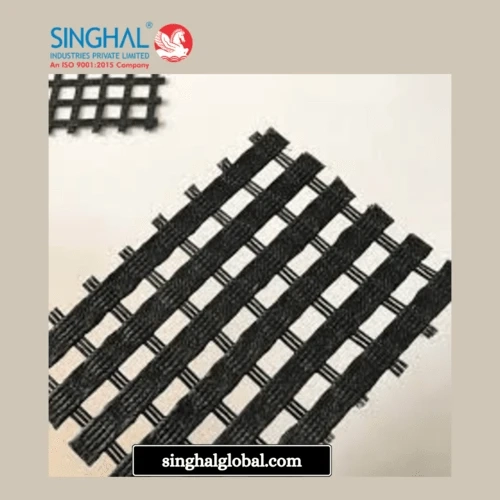The construction industry is constantly evolving, seeking new and innovative materials to enhance stability, durability, and efficiency. Among these advancements, uniaxial geogrids have emerged as a game-changer, revolutionizing the way we approach civil engineering projects. This article delves into the world of uniaxial geogrids, exploring their properties, applications, and the immense benefits they offer to the construction landscape.
Understanding Uniaxial Geogrids
Uniaxial geogrids are polymeric grids manufactured from high-strength materials like polypropylene (PP) or polyester. These grids possess a distinct orientation, with superior tensile strength in one direction. This directional strength makes them ideal for reinforcing soil and enhancing its load-bearing capacity. The grids feature apertures (openings) that allow for proper interaction with surrounding soil particles, creating a composite structure with improved mechanical properties.
PP geogrid india manufacturers produce uniaxial geogrids in various strengths and configurations to cater to diverse project requirements. The tensile strength is typically measured in kilonewtons per meter (kN/m), with common options ranging from 20 kN/m to over 1,0 kN/m. The aperture size and grid geometry also play a crucial role in performance.
Benefits of Utilizing Uniaxial Geogrids
The incorporation of uniaxial geogrids in construction projects offers a multitude of advantages:
1. Enhanced Soil Reinforcement: Uniaxial geogrids effectively interlock with soil particles, creating a mechanically stabilized earth (MSE) layer. This composite structure distributes loads more efficiently, preventing soil movement and improving overall stability.
2. Reduced Settlement: By reinforcing the soil matrix, uniaxial geogrids minimize differential settlement, a major concern in construction. This helps maintain the integrity of structures built on top of the reinforced soil layer.
3. Improved Bearing Capacity: The presence of uniaxial geogrids allows soil to withstand higher loads without failure. This translates to optimizing foundation design, potentially reducing the amount of materials required.
4. Erosion Control: Best uniaxial geogrids act as a barrier, protecting soil from erosion caused by wind, water, or traffic. This is particularly beneficial for slopes, embankments, and channels.
5. Durability and Longevity: Uniaxial geogrids are resistant to degradation from UV rays, chemicals, and biological factors. This ensures their long-term performance and minimizes the need for maintenance.
6. Cost-Effectiveness: While there is an initial investment in uniaxial geogrids, their use often leads to cost savings in the long run. Reduced material requirements for foundations, improved drainage efficiency, and minimized maintenance contribute to overall project cost reduction.
Uniaxial Geogrid Manufacturers and Price
When selecting uniaxial geogrids for a project, it is crucial to consider factors such as the specific application, required tensile strength, and UV resistance. Fortunately, India boasts a robust geosynthetics industry with several reputable Uniaxial geogrid manufacturers. These manufacturers offer a diverse range of uniaxial geogrids at competitive prices. It is recommended to research and compare products from different manufacturers to find the optimal solution for your project needs.
Applications of Uniaxial Geogrids
The versatility of uniaxial geogrids makes them suitable for a wide range of construction applications:
1. Road Construction: Uniaxial geogrids are used to reinforce road bases, reducing pavement fatigue and extending service life. They also find application in unpaved roads, improving stability and preventing rutting.
2. Retaining Walls: Reinforced soil walls constructed with uniaxial geogrids offer a cost-effective and aesthetically pleasing alternative to conventional concrete walls.
3. Slopes and Embankments: Uniaxial geogrids enhance the stability of slopes and embankments, preventing landslides and soil erosion.
4. Landfills: Geogrids are used in landfill construction to improve drainage, enhance containment, and increase overall stability.
5. Foundations: Reinforced soil foundations utilizing uniaxial geogrids provide a stable and cost-effective foundation option for various structures.
Conclusion
Uniaxial geogrids have demonstrably revolutionized the construction industry. Their ability to enhance soil stability, improve load-bearing capacity, and streamline construction processes has led to the creation of stronger, more cost-effective, and environmentally friendly infrastructure. As the demand for sustainable and efficient construction methods continues to grow, uniaxial geogrids are poised to play an even more significant role in shaping the future of construction.
FAQs (Frequently asked questions)
Q1. What is the difference between uniaxial and biaxial geogrids?
A1. Uniaxial geogrids have superior strength in one direction, while biaxial geogrids possess high tensile strength in both directions. The choice between them depends on the specific application and the type of reinforcement required.
Q2. How much do uniaxial geogrids cost in India?
A2. The price of uniaxial geogrids in India (uniaxial geogrid price) varies depending on factors like strength, roll size, and manufacturer. It typically ranges from ₹30 to ₹100 per square meter. You can directly contact uniaxial geogrid manufacturers for specific pricing information.
Q3. Where can I buy uniaxial geogrids?
A3. Several reputable construction material suppliers across India offer uniaxial geogrids. It\'s advisable to research and compare products from different manufacturers to find the best option for your project requirements.



